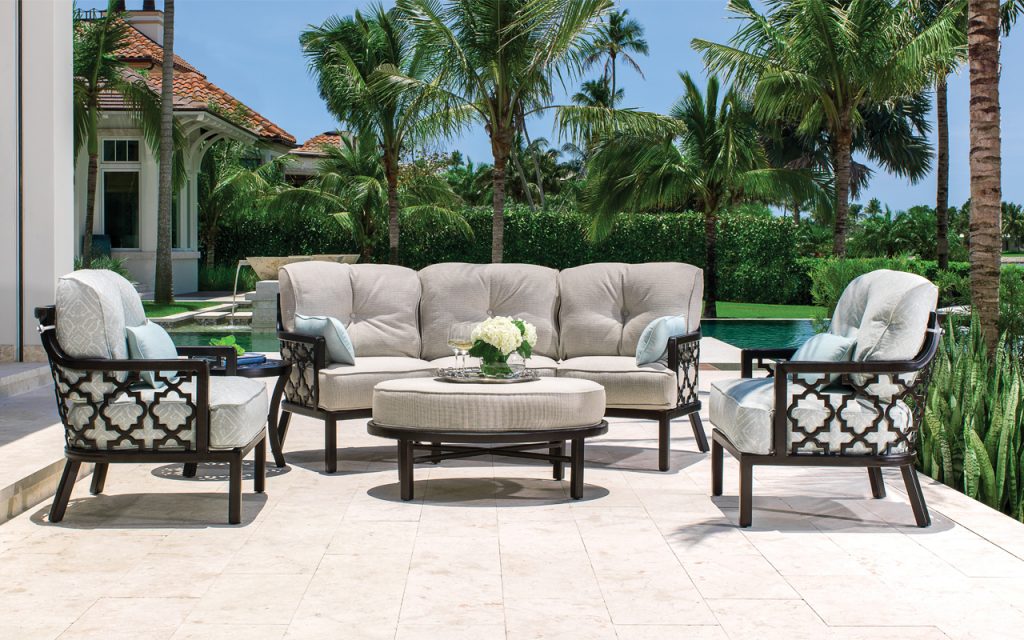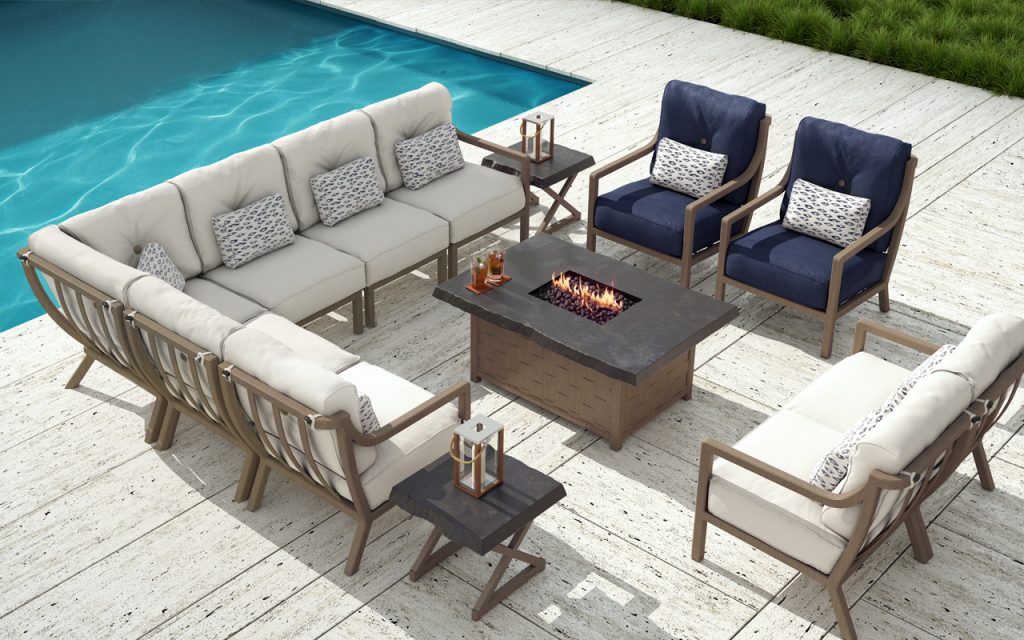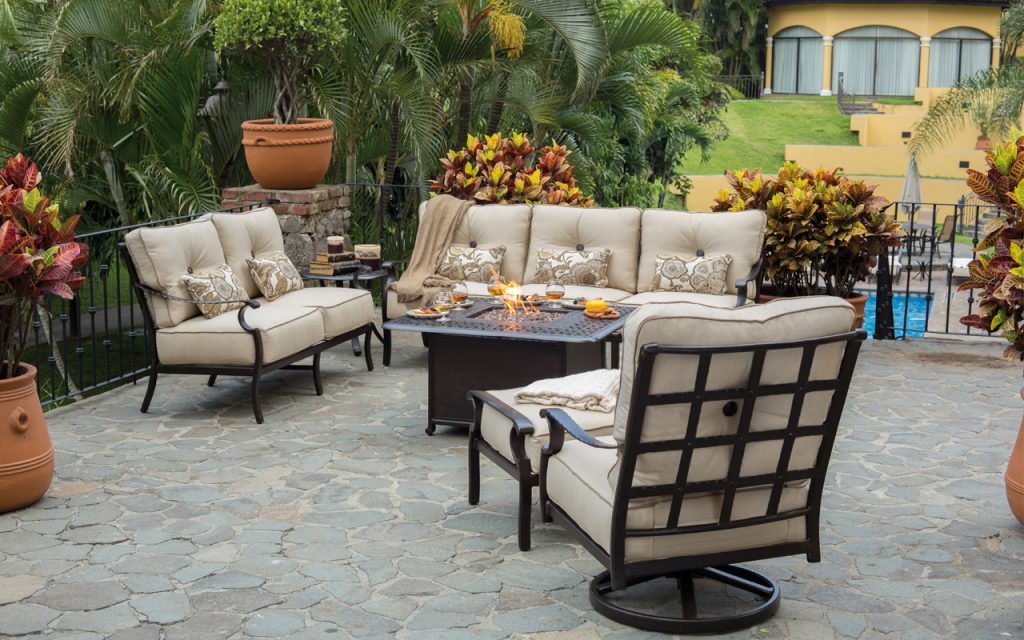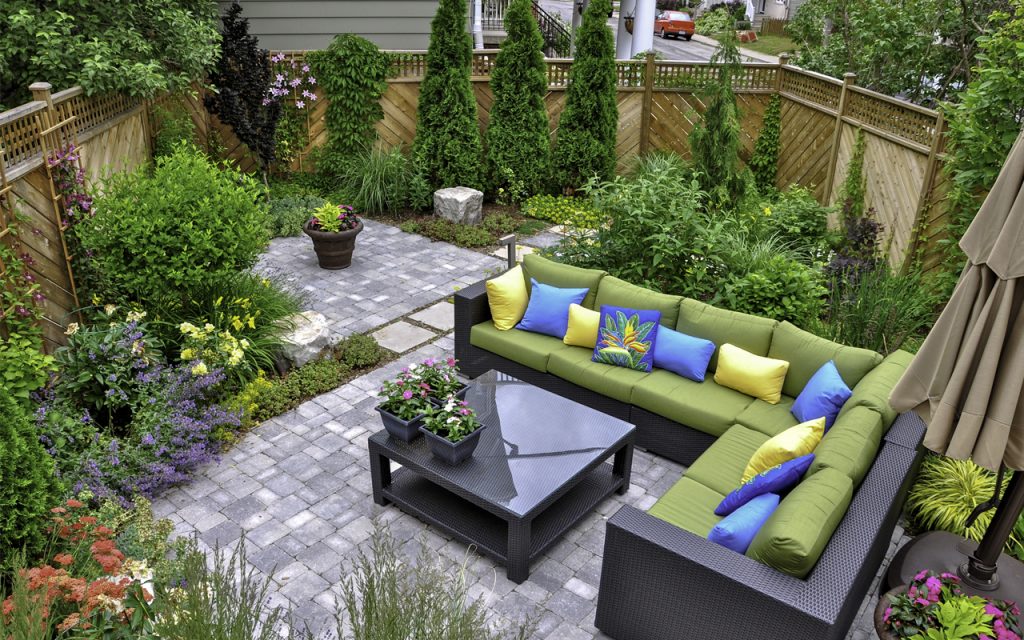
Most rooms in your home have a straightforward name and matching function. You dine in a dining room, you bathe in the bathroom, you sleep in a bed in your bedroom, etc. Picking furniture and decor for these rooms is usually self-explanatory based on functionality. Comparatively, furnishing your outdoor patio can be a much more complex task.
Personal taste will greatly affect the patio furniture you choose, but there are some basic rules you can follow to guide your decision-making and design. Some enthusiastic DIYers get carried away and forget they are furnishing an outdoor room. You never want your patio to look like you just pushed the living room sofa, lounger, coffee table outside. Even worse would be to use an old indoor sofa in the patio or backyard, something that is all too common.
Let’s discuss some of the areas where you can avoid common mistakes while designing your outdoor patio furniture layout.
1. A Colorful Problem
When it comes to issues with the color of your patio furniture, the most common mistake is using the wrong colors. Either too little color is used, the wrong colors are used (i.e. they don’t match your home), or too many colors are used.
The majority of patio furniture on the market comes in neutral colors, whites, tan, gray, beige, etc. These colors match with lots of other colors and are more of a universal choice. They can also be loud and vibrant colors, but oftentimes people will fail to match the colors properly and end up with an eye sore of a backyard.
When choosing the color of your patio furniture, focus on options in primary colors or in earth tones. You can mix and match earth tone furniture with a pop of color to great effect. If you want to branch out into more exotic colors, try using analogous colors (colors that are side-by-side on the color wheel). If none of these suit you, then try looking for furniture in your favorite colors!
2. The Wrong Amount of Furniture
When selecting your patio furniture, it is important to have accurate measurements of your outdoor space to properly plan your furniture possibilities. Getting too much furniture or conversely, too little furniture, is an easy way to mismanage your backyard. You don’t want to overcrowd your space or not have enough seating to offer your guests. Plan for the possible activities that might take place on your patio and purchase furniture accordingly.
If you are starting from scratch or are on a budget, you can often find plenty of items in good shape on local online sales websites. Try to aim for pieces that are made of the same materials (such as wood or metal) or come from the same design era. Look for stuff that is specifically meant to survive outdoors.
3. Not Enough Flair
The majority patio furniture available comes in neutral colors and earth tones, which can be quite boring in large quantities. It really does wonders for your backyard to add a pop of flair and personality. Don’t be afraid to add outdoor accessories to spice up your patio design and bring some fun into the mix.
You can add fun things like statues, candles, lighting, wind chimes, pillows, etc. Just make sure these items can stand up to the elements if they can’t be covered or moved inside. You may also want to approach this step with restraint, as too many flashy accessories can make your space busy and confusing. Just a touch of personality will do the trick.

4. Poor Furniture Arrangement
A common pitfall for patio dwellers is to have a poorly laid out furniture arrangement. Sometimes you can lose half of an area’s visual space by a simple couch being turned the wrong direction. Consider your regular usage patterns of the patio furniture and see if there are any ways to optimize your layout. If you are designing a layout, consider how you and your family will congregate in that space. For example, if you will be eating outside frequently, a large counter or outdoor table should be your focal point.
5. Lack of Foliage
A common mistake is to forget to incorporate elements of nature into your outdoor space. Plants are very good at softening the look and feel of an outdoor room. Potted plants, trees, garden fountains, vases full of flowers are all good options for a patio. If you are smart about it, you can get some plants with pleasant aromas to really amp up the relaxation factor in your backyard.
6. Size and Scale
Minimalism is a popular modern style, but if followed too closely, it can leave your patio feeling barren and uninviting. It’s important to have a plan for the furniture you plan to get, especially when it comes to the size and relative scale to your other pieces. Pieces that are too small and spread out can leave a backyard wanting, while mismatching pieces can lead to a sense of overcrowding.
You definitely want to avoid overcrowding your patio with furniture, especially if you are a collector of used furniture. The last thing you want is to have your backyard look like you are having a perpetual garage sale.
7. Using the Wrong Materials
When selecting outdoor furniture, you’re probably going to look for many of the same characteristics that you look for with indoor furniture – durability, comfort, style, and price. The primary difference is that your patio furniture will need to endure regular exposure to the elements. No matter your style, an important consideration is how well your furniture will hold up to weather conditions, including moisture, the sun and strong winds. While there is virtually no 100% weatherproof patio furniture, there are big differences based on the materials used.
Before you make a purchase, it’s important to understand the pros and cons of the various material options. Choosing the best material for outdoor patio furniture is dependent on matching your needs with the inherent qualities of each material.

Factors to Consider for Outdoor Patio Furniture Materials
When deciding on the material of your patio furniture, there are quite a few factors to consider. The most important factors relate to a material’s ability to survive against constant exposure to the elements. Will the structural integrity hold up? Will the material degrade in the sun? How often will these materials require maintenance? These are the basics, but let’s look at some of the other challenging factors to consider.
Rain & Moisture
If you live in an area where rain is frequent or that has high humidity, you want to be sure that your furniture is resistant to damage from water. Standing water or retained moisture can physically degrade most materials.
Mold, Mildew & Rot
Humid or moist conditions create an environment where various fungi thrive. Organic materials that retain water are susceptible to mold and mildew. Luckily, they don’t damage most materials and can simply be cleaned off. Rot, on the other hand, leads to biodegradation and decomposition of the material.
Rust & Corrosion
Metals that contain iron or steel are vulnerable to corrosion when they are continually exposed to water and oxygen. The corrosive oxidation process slowly weakens these metals, resulting in visible rust and other discoloration. Salt in the air and water accelerate the chemical process, so rusting is often more prevalent in coastal regions or if you have a pool in your backyard.
Warping
Materials that allow water penetration can dry unevenly, resulting in warping of the original shape. It may be imperceptible at first, but over time it can distort the material, misalign seams, loosen screws and other fasteners used to hold the furniture together.
Cracking
Some materials expand and contract when they are heated or cooled. They can crack, split, warp or become brittle when exposed to extreme temperatures or drastic fluctuations. Dry air can also cause furniture to bend and crack.
Wind
If you live in an extremely windy area, it’s important that your outdoor furniture is heavy enough that it doesn’t tip over or blow away.
Cleaning & Care Difficulty
The look and functional durability of your patio furniture is also affected by how well you take care of it. Some materials require very little attention and are easy to clean with soap and water. Others require more time-intensive care and special products to keep them looking great and working properly. If your time is at a premium, or you just don’t want the hassle, you may want to opt for lower maintenance materials.

Cost
At the end of the day, most everyone looks at the financial implications of choosing one material over another for furniture. You need to stay within your budget, but it’s also important to understand how expensive materials are in the long run and their price versus benefits value. Will it need to be replaced frequently? Does it take an inordinate amount of time and effort to maintain? These are key cost considerations for designing the perfect patio furniture that you might not immediately think of when evaluating alternatives.
